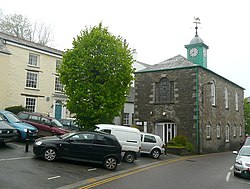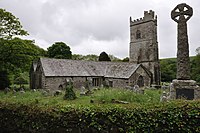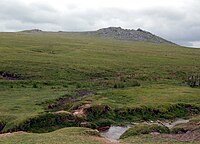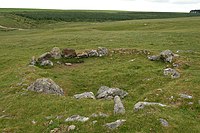Camelford
| Camelford Cornish: Reskammel | |
| Cornwall | |
|---|---|
 The Town Hall, Camelford | |
| Location | |
| Grid reference: | SX101831 |
| Location: | 50°37’1"N, 4°40’59"W |
| Data | |
| Population: | 2,256 (2001) |
| Post town: | Camelford |
| Postcode: | PL32 |
| Dialling code: | 01840 |
| Local Government | |
| Council: | Cornwall |
| Parliamentary constituency: |
North Cornwall |
Camelford is a town in north Cornwall, in the River Camel valley northwest of Bodmin Moor. The town is approximately ten miles north of Bodmin.
Lanteglos-by-Camelford is the ecclesiastical parish to which the town belongs.
The two main industrial enterprises in the area are the slate quarry at Delabole and the cheese factory at Davidstow but there is a small industrial estate at Highfield.
The A39 "Atlantic Highway" passes directly through the town centre: a bypass has been discussed for many years. Camelford Station was some distance from the town and closed in 1966; the site was subsequently used as a cycling museum.
Churches

The parish church of Camelford is at Lanteglos by Camelford though there is also a Church of St Thomas of Canterbury (opened in 1938) in the town.[1]
Langdon (1896) recorded the existence of seven stone crosses in the parish, including three at the rectory (Lanteglos Rectory was converted into a guesthouse in the mid-20th century). There was in mediæval times a chapel of St Thomas which probably fell into disuse after the Reformation (it is recorded in 1312).[2] The Rector of Lanteglos is also responsible for the adjacent parish of Advent.
In Market Place is the Methodist Church (originally a Wesleyan Methodist Chapel).[3] The founder of Methodism, John Wesley, visited Camelford on several occasions during his journeys in Cornwall.[4] In the 1830s and 1840s the Camelford Wesleyan Methodist circuit underwent a secession by more than half the members to the Wesleyan Methodist Association.[5] There is an older Methodist chapel (now disused) in Chapel Street.
Soul's Harbour Pentecostal Church is situated on the Clease adjacent to the car park. It is affiliated with The Assemblies of God of Great Britain and was founded in 1987. The building the Church occupies was built as the Church School in 1846.
Geography


Its position near the highest land in Cornwall makes Camelford’s climate rather wet. On 8 June 1957, eight inches of rain fell at Camelford.
Roughtor is the nearest of the hills of Bodmin Moor to the town and numerous prehistoric remains can be found nearby as well. The Town Hall was built in 1806, but is now used as a branch public library. By the riverside is Enfield Park; hamlets in the parish include Helstone, Tregoodwell, Valley Truckle, Hendra, Lanteglos, Slaughterbridge, Tramagenna, Treforda and Trevia.[6] The economy depends largely on agriculture and tourism; there is a china clay works at Stannon.
History
Due to its name, it has been linked to the legendary Camelot and the Camlann of the ancient chronicles, but historians have been quick to refute these suggestions. Nearby Slaughterbridge is supposed to be the site of a battle. The origin of the town’s name is probably from the original name of the river (Allen) in combination with cam-=crooked and the English 'ford', though this is not accepted by all.
The town was formaerly a borough which elected two members to the House of Commons, a right first used in the Parliament of 1552. It was later considered a rotten borough and its franchise was abolished in 1832.
The seal of the borough shows: Arg. a camel passing through a ford of water all proper with legend "Sigillum Vill: de Camelford".[7]
Water pollution incident
In July 1988, national attention turned to Camelford when 20 tons of aluminium sulphate was poured into the wrong tank at the nearby Lowermoor Water Treatment Works on Bodmin Moor and poisoned the water supply to the town and the surrounding area. An independent inquiry into Camelford water pollution incident|the incident (the worst of its kind in British history) was started in 2002, and a draft report issued in January 2005, but questions still remain as to the long-term effects on the health of local residents. Michael Meacher, who visited Camelford in his post as environment minister, called the incident and its aftermath, "A most unbelievable scandal."[8]
Manor of Helston in Trigg
Helstone (or Helston in Trigg) was in the Middle Ages one of the chief manors of the Hundred of Trigg. In the Domesday Book this manor was held by Earl Robert of Mortain: there were 2 hides, land for 15 ploughs; the lord had 4 ploughs & 18 serfs; 20 villagers & 18 smallholders had 8 ploughs; 10 acres of woodland; 6 square leagues of pasture; five kinds of livestock, in total 195 beasts. The manor of Penmayne was a dependency of this manor.[9] It was one of the 17 Antiqua maneria of the Duchy of Cornwall.
Sights about Camelford

Camelford is the home of the North Cornwall Museum and Gallery which contains paintings and objects of local historical interest.
To the northwest at Slaughterbridge is an Arthurian Centre and at nearby Camelford Station is the Cycling Museum (temporarily closed 2010).
To the east are the hills of Rough Tor and Brown Willy and to the south the old parish churches at Lanteglos and Advent.
Notable people associated with Camelford
- Samuel Wallis, naval officer, was born near Camelford. Among his achievements was the circumnavigation of the world.
- Francis Hurdon, the Canadian politician, was also born at Camelford.
- Pitt Family; two members held the title of Baron Camelford: Thomas Pitt, 1st Baron Camelford (1737–1793) and Thomas Pitt, 2nd Baron Camelford (1775–1804).
- Samuel Pollard, missionary to China was born in Camelford.
Outside links
- Camelford Town Council
- Government Inquiry Report, 2005
- Cornwall Record Office Online Catalogue for Camelford
References
- ↑ A Church Near You. "Parish of Lanteglos by Camelford". http://www.achurchnearyou.com/lanteglos-st-julitta/. Retrieved 2009-04-17.
- ↑ George Oliver, Monasticon
- ↑ http://www.heritagegateway.org.uk/Gateway/Results_Single.aspx?uid=68517&resourceID=5
- ↑ Pearce, John (ed.) (1964) The Wesleys in Cornwall: Extracts from the Journals of John and Charles Wesley and John Nelson. Truro: D. Bradford Barton
- ↑ Shaw, Thomas (1967) A History of Cornish Methodism; chap, 5. Truro: D. Bradford Barton
- ↑ Cornwall; Explore Britain
- ↑ Pascoe, W. H. (1979) A Cornish Armory. Padstow: Lodenek Press; p. 132
- ↑ The Independent, 16 April 2006, Poisoned: The Camelford scandal
- ↑ Thorn, C., et al. (eds.) (1979) Cornwall. Chichester: Phillimore; entry 5,1,4